Analysis of the
SallenĆKey Architecture
Application
Report
July 1999 – Revised September 2002
Mixed Signal Products
SLOA024B
�
IMPORTANT NOTICE
Texas Instruments Incorporated and its subsidiaries (TI) reserve the right to make corrections, modifications,
enhancements, improvements, and other changes to its products and services at any time and to discontinue
any product or service without notice. Customers should obtain the latest relevant information before placing
orders and should verify that such information is current and complete. All products are sold subject to TI’s terms
and conditions of sale supplied at the time of order acknowledgment.
TI warrants performance of its hardware products to the specifications applicable at the time of sale in
accordance with TI’s standard warranty. Testing and other quality control techniques are used to the extent TI
deems necessary to support this warranty. Except where mandated by government requirements, testing of all
parameters of each product is not necessarily performed.
TI assumes no liability for applications assistance or customer product design. Customers are responsible for
their products and applications using TI components. To minimize the risks associated with customer products
and applications, customers should provide adequate design and operating safeguards.
TI does not warrant or represent that any license, either express or implied, is granted under any TI patent right,
copyright, mask work right, or other TI intellectual property right relating to any combination, machine, or process
in which TI products or services are used. Information published by TI regarding third–party products or services
does not constitute a license from TI to use such products or services or a warranty or endorsement thereof.
Use of such information may require a license from a third party under the patents or other intellectual property
of the third party, or a license from TI under the patents or other intellectual property of TI.
Reproduction of information in TI data books or data sheets is permissible only if reproduction is without
alteration and is accompanied by all associated warranties, conditions, limitations, and notices. Reproduction
of this information with alteration is an unfair and deceptive business practice. TI is not responsible or liable for
such altered documentation.
Resale of TI products or services with statements different from or beyond the parameters stated by TI for that
product or service voids all express and any implied warranties for the associated TI product or service and
is an unfair and deceptive business practice. TI is not responsible or liable for any such statements.
Mailing Address:
Texas Instruments
Post Office Box 655303
Dallas, Texas 75265
Copyright 2002, Texas Instruments Incorporated
�
1 Introduction
. . . . . . . . . . . . . . . . . . . . . . . . . . . . . . . . . . . . . . . . . . . . . . . . . . . . . . . . . . . . . . . . . . . . . . . . . . . . . . . . . . .
1
Contents
2 Generalized Circuit Analysis
2.1 Gain Block Diagram
2.2 Ideal Transfer Function
. . . . . . . . . . . . . . . . . . . . . . . . . . . . . . . . . . . . . . . . . . . . . . . . . . . . . . . . . . . . . . . . . . . .
. . . . . . . . . . . . . . . . . . . . . . . . . . . . . . . . . . . . . . . . . . . . . . . . . . . . . . . . . . . . . . . . . . . . . . .
. . . . . . . . . . . . . . . . . . . . . . . . . . . . . . . . . . . . . . . . . . . . . . . . . . . . . . . . . . . . . . . . . . . .
3 Low-Pass Circuit
3.1 Simplification 1: Set Filter Components as Ratios
3.2 Simplification 2: Set Filter Components as Ratios and Gain = 1
3.3 Simplification 3: Set Resistors as Ratios and Capacitors Equal
3.4 Simplification 4: Set Filter Components Equal
3.5 Nonideal Circuit Operation
3.6 Simulation and Lab Data
. . . . . . . . . . . . . . . . . . . . . . . . . . . . . . . . . . . . . . . . . . . . . . . . . . . . . . . . . . . . . . . . . . . . . . . . . . . . . . .
. . . . . . . . . . . . . . . . . . . . . . . . . . . . . . . . . . . . . . . . . . . .
. . . . . . . . . . . . . . . . . . . . . . . . . . . . . . . .
. . . . . . . . . . . . . . . . . . . . . . . . . . . . . . . . .
. . . . . . . . . . . . . . . . . . . . . . . . . . . . . . . . . . . . . . . . . . . . . . . .
. . . . . . . . . . . . . . . . . . . . . . . . . . . . . . . . . . . . . . . . . . . . . . . . . . . . . . . . . . . . . . . . .
. . . . . . . . . . . . . . . . . . . . . . . . . . . . . . . . . . . . . . . . . . . . . . . . . . . . . . . . . . . . . . . . . .
2
2
3
4
5
5
5
5
6
6
4 High-Pass Circuit
4.1 Simplification 1: Set Filter Components as Ratios
4.2 Simplification 2: Set Filter Components as Ratios and Gain=1
4.3 Simplification 3: Set Resistors as Ratios and Capacitors Equal
4.4 Simplification 4: Set Filter Components as Equal
4.5 Nonideal Circuit Operation
4.6 Lab Data
. . . . . . . . . . . . . . . . . . . . . . . . . . . . . . . . . . . . . . . . . . . . . . . . . . . . . . . . . . . . . . . . . . . . . . . . . . . . . .
. . . . . . . . . . . . . . . . . . . . . . . . . . . . . . . . . . . . . . . . . . .
. . . . . . . . . . . . . . . . . . . . . . . . . . . . . . . .
. . . . . . . . . . . . . . . . . . . . . . . . . . . . . . . .
. . . . . . . . . . . . . . . . . . . . . . . . . . . . . . . . . . . . . . . . . . . .
. . . . . . . . . . . . . . . . . . . . . . . . . . . . . . . . . . . . . . . . . . . . . . . . . . . . . . . . . . . . . . . .
. . . . . . . . . . . . . . . . . . . . . . . . . . . . . . . . . . . . . . . . . . . . . . . . . . . . . . . . . . . . . . . . . . . . . . . . . . . . . . .
9
10
10
10
10
11
11
5 Summary and Comments About Component Selection
. . . . . . . . . . . . . . . . . . . . . . . . . . . . . . . . . . . . . . . . . .
13
Analysis of the Sallen-Key Architecture
iii
�
Figures
List of Figures
1 Basic Second Order Low-Pass Filter
2 Unity Gain Sallen-Key Low-Pass Filter
3 Generalized Sallen-Key Circuit
4 Gain-Block Diagram of the Generalized Sallen-Key Filter
5 Low-Pass Sallen-Key Circuit
6 Nonideal Effect of Amplifier Output Impedance and Transfer Function
7 Test Circuits
8 Effect of Output Impedance
9 High-Pass Sallen-Key Circuit
10 Model of High-Pass Sallen-Key Filter Above fc
11 High-Pass Sallen-Key Filter Using THS3001
12 Frequency Response of High-Pass Sallen-Key Filter Using THS3001
. . . . . . . . . . . . . . . . . . . . . . . . . . . . . . . . . . . . . . . . . . . . . . . . . . . . . . . . . . . . . . .
. . . . . . . . . . . . . . . . . . . . . . . . . . . . . . . . . . . . . . . . . . . . . . . . . . . . . . . . . . . . . .
. . . . . . . . . . . . . . . . . . . . . . . . . . . . . . . . . . . . . . . . . . . . . . . . . . . . . . . . . . . . . . . . . . . . .
. . . . . . . . . . . . . . . . . . . . . . . . . . . . . . . . . . . . . . . . . . . . . .
. . . . . . . . . . . . . . . . . . . . . . . . . . . . . . . . . . . . . . . . . . . . . . . . . . . . . . . . . . . . . . . . . . . . . . .
. . . . . . . . . . . . . . . . . . . . . . . . . . . . . . . . . . .
. . . . . . . . . . . . . . . . . . . . . . . . . . . . . . . . . . . . . . . . . . . . . . . . . . . . . . . . . . . . . . . . . . . . . . . . . . . . . . . . . . . . .
. . . . . . . . . . . . . . . . . . . . . . . . . . . . . . . . . . . . . . . . . . . . . . . . . . . . . . . . . . . . . . . . . . . . . . .
. . . . . . . . . . . . . . . . . . . . . . . . . . . . . . . . . . . . . . . . . . . . . . . . . . . . . . . . . . . . . . . . . . . . . .
. . . . . . . . . . . . . . . . . . . . . . . . . . . . . . . . . . . . . . . . . . . . . . . . . . . . .
. . . . . . . . . . . . . . . . . . . . . . . . . . . . . . . . . . . . . . . . . . . . . . . . . . . . . . .
. . . . . . . . . . . . . . . . . . . . . . . . . . . . . . . . .
1
1
2
3
4
6
7
8
9
11
12
12
iv
SLOA024B
�
Analysis of the Sallen-Key Architecture
James Karki
ABSTRACT
This application report discusses the Sallen-Key architecture. The report gives a general
overview and derivation of the transfer function, followed by detailed discussions of
low-pass and high-pass filters, including design information, and ideal and non-ideal
operation. To illustrate the limitations of real circuits, data on low-pass and high-pass
filters using the Texas Instruments THS3001 is included. Finally, component selection is
discussed.
1 Introduction
Figure 1 shows a two-stage RC network that forms a second order low-pass filter.
This filter is limited because its Q is always less than 1/2. With R1=R2 and C1=C2,
Q=1/3. Q approaches the maximum value of 1/2 when the impedance of the
second RC stage is much larger than the first. Most filters require Qs larger than
1/2.
VI
R1
R2
C2
VO
C1
=
Vo
Vi
)
1C2R2C1Rs
(
2
+
1
+
(
1C1R1C2R2C1Rs
+
) 1
+
Figure 1. Basic Second Order Low-Pass Filter
Larger Qs are attainable by using a positive feedback amplifier. If the positive
feedback is controlled—localized to the cut-off frequency of the filter—almost any
Q can be realized, limited mainly by the physical constraints of the power supply
and component tolerances. Figure 2 shows a unity gain amplifier used in this
manner. Capacitor C2, no longer connected to ground, provides a positive
feedback path. In 1955, R. P. Sallen and E. L. Key described these filter circuits,
and hence they are generally known as Sallen-Key filters.
R1
VI
R2
C2
C1
+
–
VO
Figure 2. Unity Gain Sallen-Key Low-Pass Filter
The operation can be described qualitatively:
• At low frequencies, where C1 and C2 appear as open circuits, the signal is
simply buffered to the output.
• At high frequencies, where C1 and C2 appear as short circuits, the signal is
shunted to ground at the amplifier’s input, the amplifier amplifies this input to
its output, and the signal does not appear at Vo.
• Near the cut-off frequency, where the impedance of C1 and C2 is on the same
order as R1 and R2, positive feedback through C2 provides Q enhancement
of the signal.
1
�
Generalized Circuit Analysis
2 Generalized Circuit Analysis
The circuit shown in Figure 3 is a generalized form of the Sallen-Key circuit,
where generalized impedance terms, Z, are used for the passive filter
components, and R3 and R4 set the pass–band gain.
Vf
VI
Z1
Z2
Z4
Vp
Vn
+
–
3
Z
VO
R4
R3
Figure 3. Generalized Sallen-Key Circuit
To find the circuit solution for this generalized circuit, find the mathematical relationships
between Vi, Vo, Vp, and Vn, and construct a block diagram.
KCL at Vf:
Vfǒ 1
KCL at Vp:
Vpǒ 1
Z1 )
1
Z2 )
Z4Ǔ + Viǒ 1
1
Z1Ǔ ) Vpǒ 1
Z2Ǔ ) Voǒ 1
Z4Ǔ
Z2 )
Z3Ǔ + Vfǒ 1
1
Z2Ǔ å Vf + Vpǒ1 )
Z2
Z3Ǔ
Substitute Equation (2) into Equation (1) and solve for Vp:
Vp + Viǒ
Z2Z3Z4
Z2Z3Z4 ) Z1Z2Z4 ) Z1Z2Z3 ) Z2Z2Z4 ) Z2Z2Z1Ǔ )
Z2Z3Z4 ) Z1Z2Z4 ) Z1Z2Z3 ) Z2Z2Z4 ) Z2Z2Z1Ǔ
Z1Z2Z3
Voǒ
KCL at Vn:
Vnǒ 1
R3 )
R4Ǔ + Voǒ 1
1
R4Ǔ å Vn + Voǒ R3
R3 ) R4Ǔ
2.1 Gain Block Diagram
By letting: a(f) = the open-loop gain of the amplifier, b + ǒ R3
c +
Z2Z3Z4 ) Z1Z2Z4 ) Z1Z2Z3 ) Z2Z2Z4 ) Z2Z2Z1
Z2Z3Z4
R3 ) R4Ǔ,
,
d +
Z2Z3Z4 ) Z1Z2Z4 ) Z1Z2Z3 ) Z2Z2Z4 ) Z2Z2Z1
Z1Z2Z3
,
and Ve = Vp – Vn, the generalized Sallen-Key filter circuit is represented in
gain-block form as shown in Figure 4.
2
SLOA024B
(1)
(2)
(3)
(4)
�
Generalized Circuit Analysis
VI
c
Ve
+
+
–
d
b
a(f)
VO
Figure 4. Gain-Block Diagram of the Generalized Sallen-Key Filter
From the gain-block diagram the transfer function can be solved easily by
observing, Vo = a(f)Ve and Ve = cVi + dVo – bVo. Solving for the generalized
transfer function from gain block analysis gives:
Vo
ȡ
bǓȧȧ
Vi + ǒc
1 )
Ȣ
1
1
aǒfǓb *
ȣ
ȧȧ
d
Ȥ
b
2.2 Ideal Transfer Function
Assuming a(f)b is very large over the frequency of operation, 1
transfer function from gain block analysis becomes:
a(f)b [ 0, the ideal
Vo
ȣ
ȡ
bǓȧ
Vi + ǒc
1
ȧ
d
1 *
Ȥ
Ȣ
b
b + K, c +
N2
D
By letting 1
, where N1, N2, and D are the
numerators and denominators shown above, the ideal equation can be rewritten
as:
, and d +
N1
D
K
ȡ
ȣ
Vo
Vi +ȧ
ȧ
. Plugging in the generalized impedance terms gives the
D
N1 * K@N2
Ȣ
Ȥ
N1
ideal transfer function with impedance terms:
Vo
Vi +
Z1Z2
Z3Z4 )
Z1
Z3 )
K
Z2
Z3 )
Z1ǒ1*KǓ
Z4 ) 1
(5)
(6)
(7)
Analysis of the Sallen-Key Architecture
3
�
Low-Pass Circuit
3 Low-Pass Circuit
The standard frequency domain equation for a second order low-pass filter is:
HLP +
2
K
)
* ǒ f
fcǓ
jf
Qfc ) 1
(8)
Where fc is the corner frequency (note that fc is the breakpoint between the pass
band and stop band, and is not necessarily the –3 dB point) and Q is the quality
factor. When f<>fc, Equation (8) reduces to * Kǒfc
f Ǔ
, and
signals are attenuated by the square of the frequency ratio. With attenuation at
higher frequencies increasing by a power of 2, the formula describes a second
order low-pass filter.
Figure 5 shows the Sallen-Key circuit configured for low-pass:
Z1 + R1, Z2 + R2, Z3 +
1
,
sC1
Z4 +
1
sC2
, and K + 1 )
R4
R3
.
R1
R2
VI
C1
C2
+
–
R4
R3
VO
Figure 5. Low-Pass Sallen-Key Circuit
From Equation (7), the ideal low-pass Sallen-Key transfer function is:
Vo
Vi
(Ip) +
By letting
s2(R1R2C1C2) ) s(R1C1 ) R2C1 ) R1C2(1 * K)) ) 1
K
(9)
1
Ǹ
fc +
2p R1R2C1C2
s + j2pf,
equation (9) follows the same form as Equation (8). With some simplifications,
these equations can be dealt with efficiently; the following paragraphs discuss
commonly used simplification methods.
R1C1 ) R2C1 ) R1C2(1 * K)
, and Q +
Ǹ
R1R2C1C2
,
4
SLOA024B
�
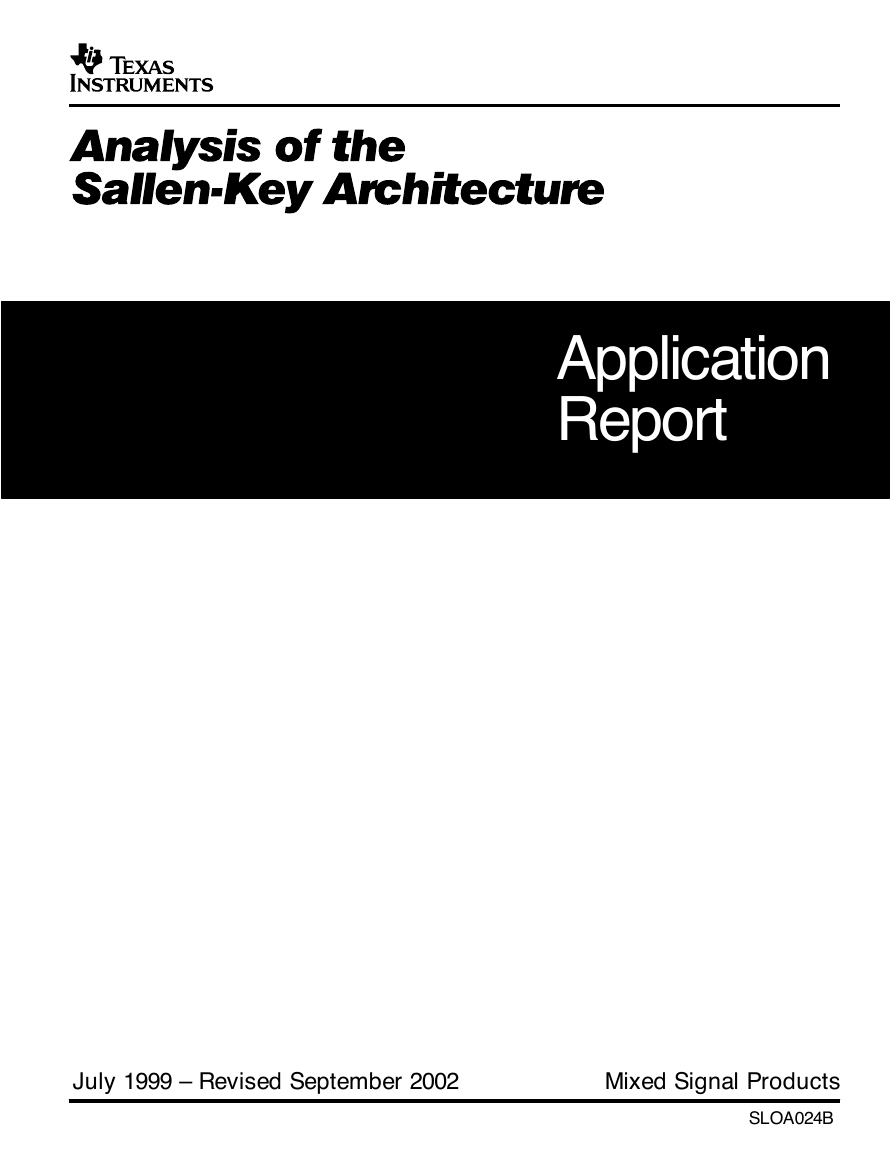
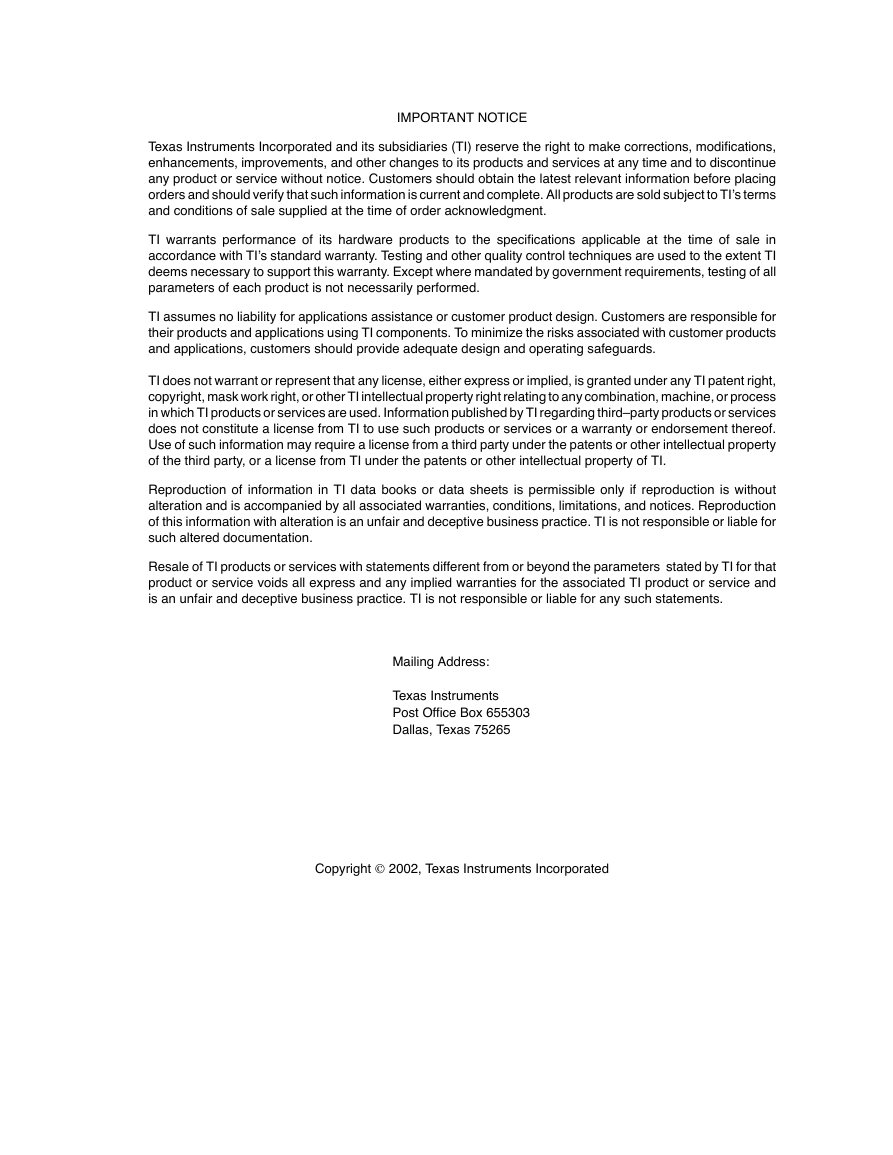
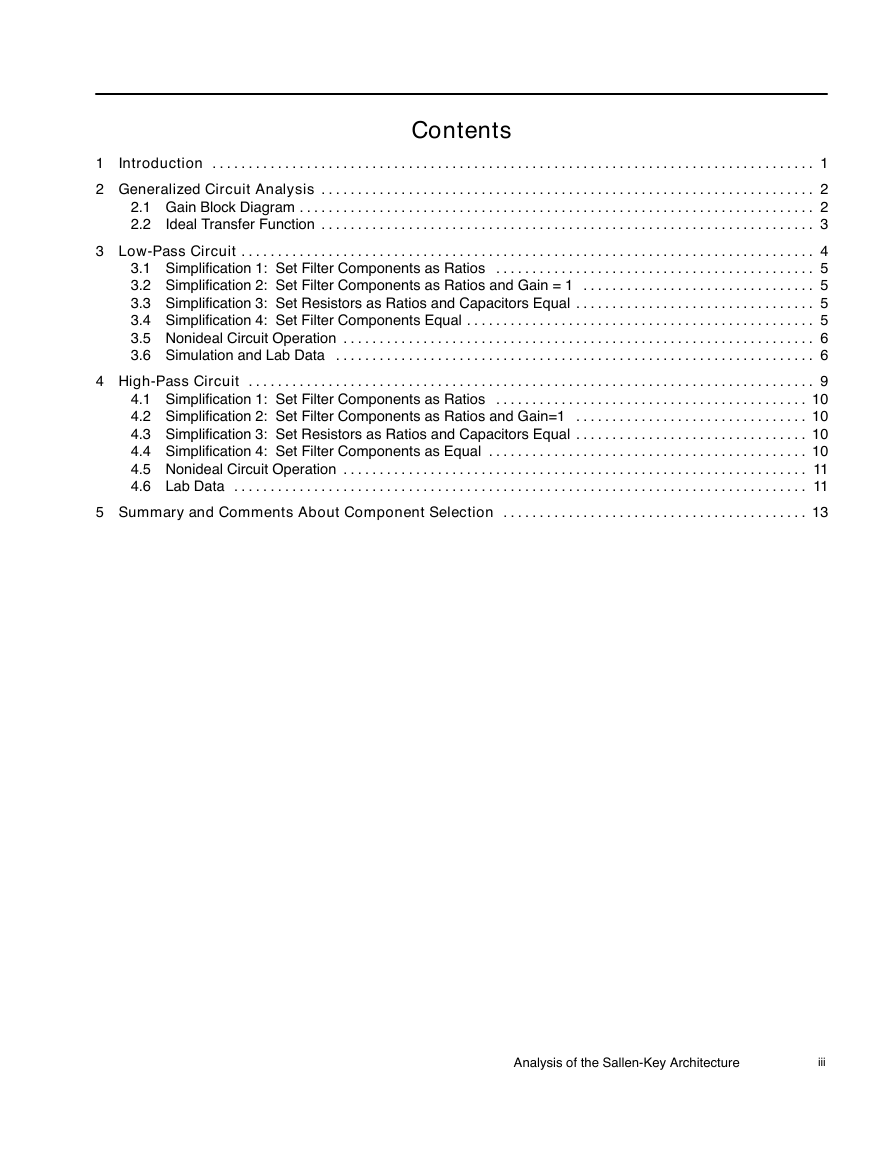
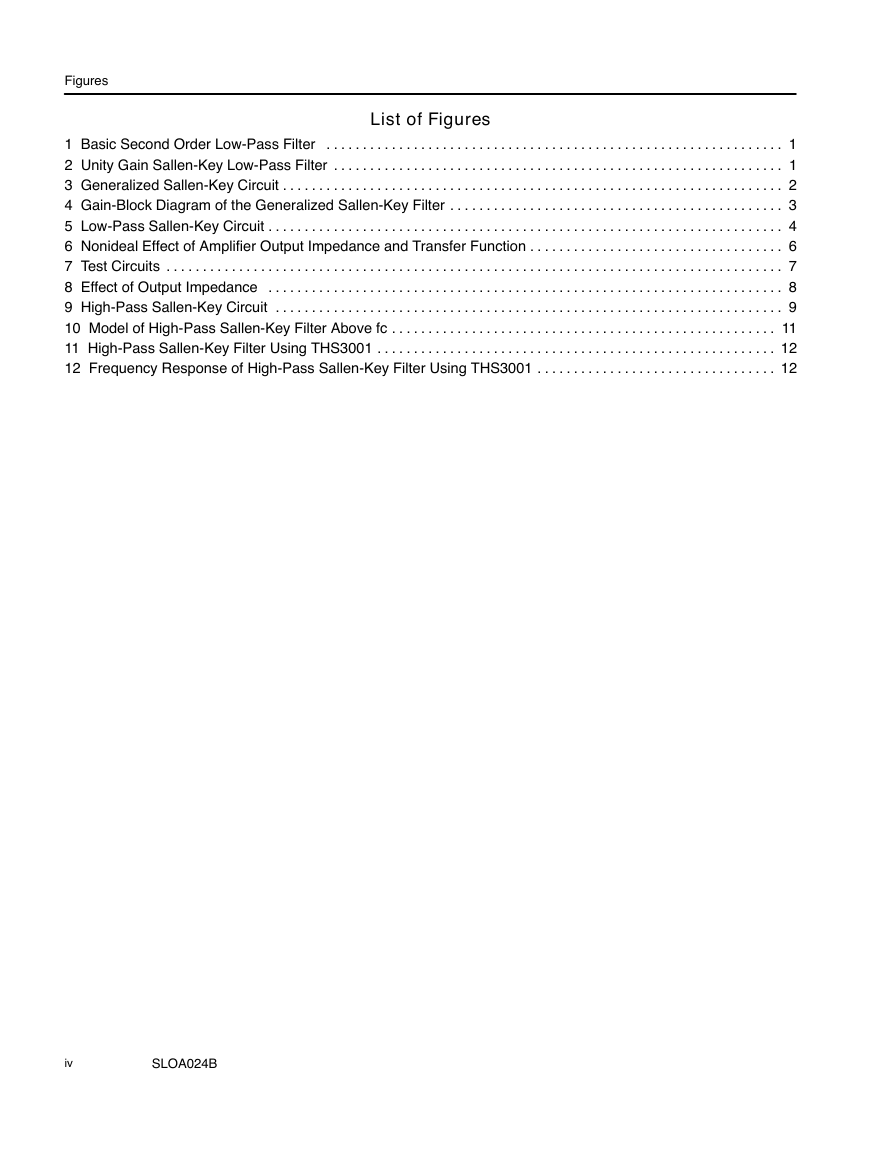
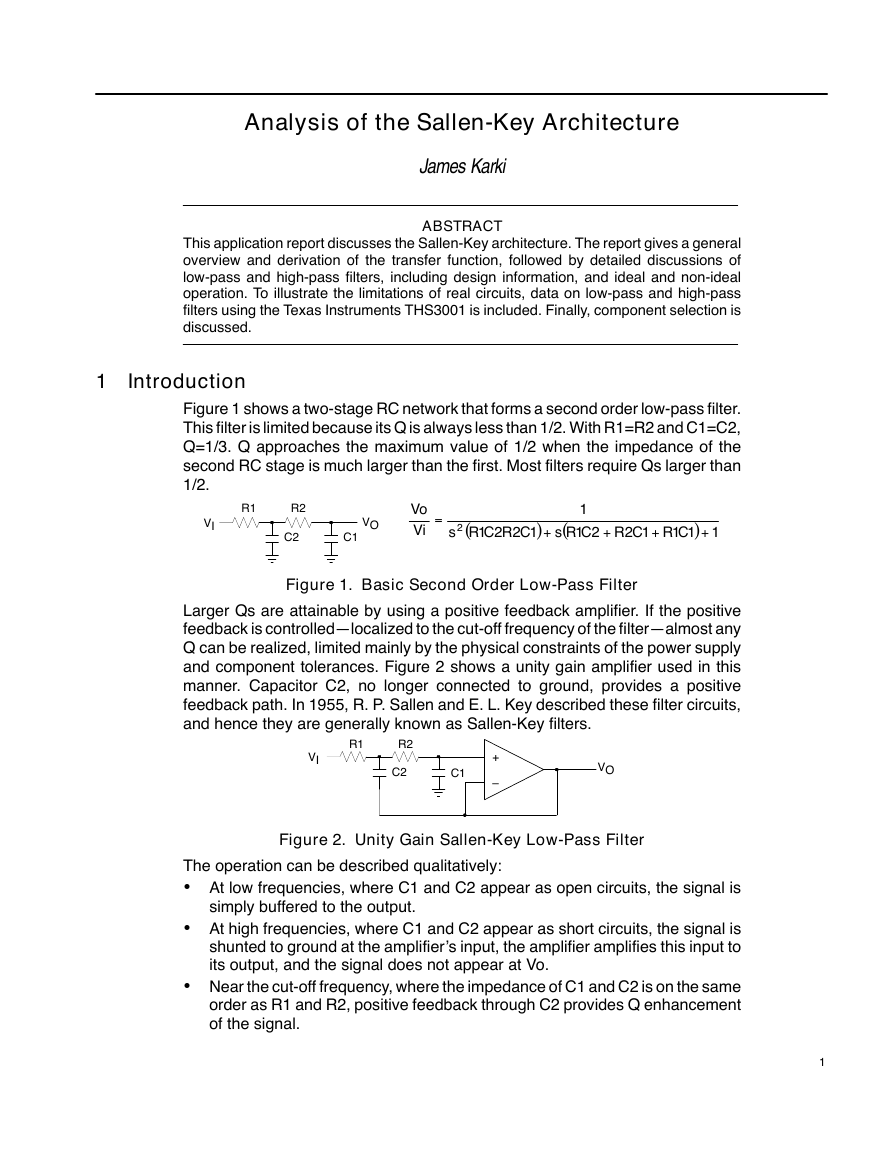

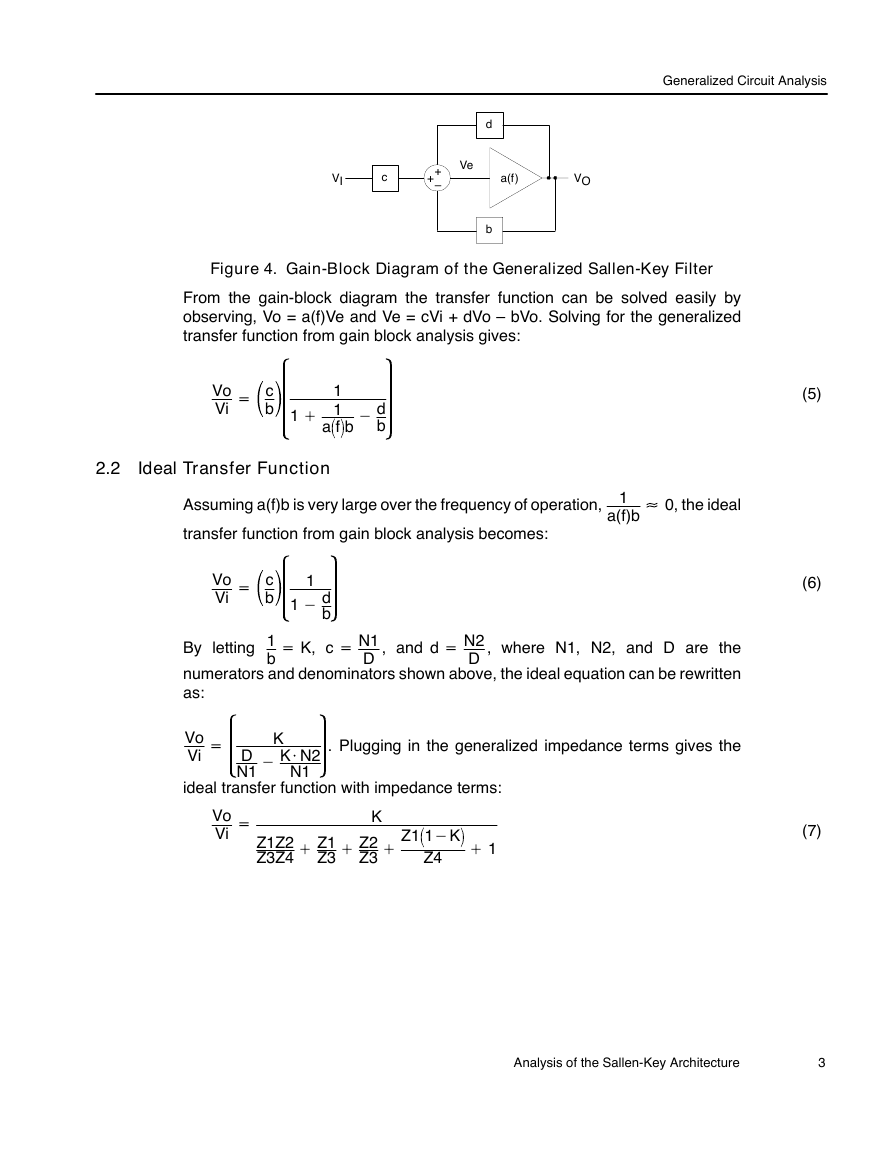
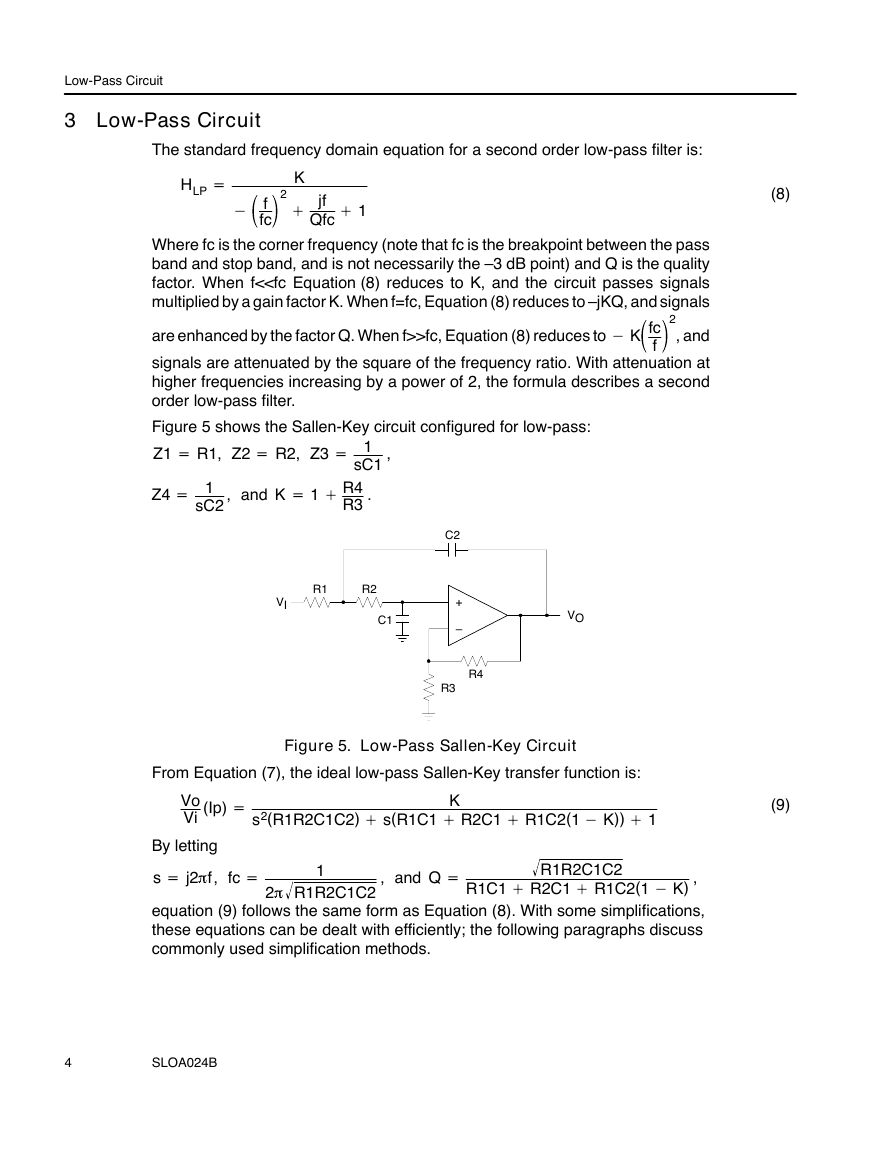








 2023年江西萍乡中考道德与法治真题及答案.doc
2023年江西萍乡中考道德与法治真题及答案.doc 2012年重庆南川中考生物真题及答案.doc
2012年重庆南川中考生物真题及答案.doc 2013年江西师范大学地理学综合及文艺理论基础考研真题.doc
2013年江西师范大学地理学综合及文艺理论基础考研真题.doc 2020年四川甘孜小升初语文真题及答案I卷.doc
2020年四川甘孜小升初语文真题及答案I卷.doc 2020年注册岩土工程师专业基础考试真题及答案.doc
2020年注册岩土工程师专业基础考试真题及答案.doc 2023-2024学年福建省厦门市九年级上学期数学月考试题及答案.doc
2023-2024学年福建省厦门市九年级上学期数学月考试题及答案.doc 2021-2022学年辽宁省沈阳市大东区九年级上学期语文期末试题及答案.doc
2021-2022学年辽宁省沈阳市大东区九年级上学期语文期末试题及答案.doc 2022-2023学年北京东城区初三第一学期物理期末试卷及答案.doc
2022-2023学年北京东城区初三第一学期物理期末试卷及答案.doc 2018上半年江西教师资格初中地理学科知识与教学能力真题及答案.doc
2018上半年江西教师资格初中地理学科知识与教学能力真题及答案.doc 2012年河北国家公务员申论考试真题及答案-省级.doc
2012年河北国家公务员申论考试真题及答案-省级.doc 2020-2021学年江苏省扬州市江都区邵樊片九年级上学期数学第一次质量检测试题及答案.doc
2020-2021学年江苏省扬州市江都区邵樊片九年级上学期数学第一次质量检测试题及答案.doc 2022下半年黑龙江教师资格证中学综合素质真题及答案.doc
2022下半年黑龙江教师资格证中学综合素质真题及答案.doc